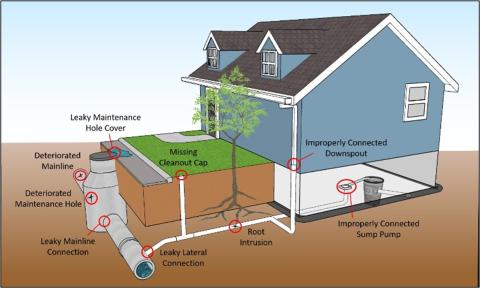Overview
The Town of Georgina is working with Civica Infrastructure on an Inflow and Infiltration (I and I) Reduction study. The objectives are to identify sources of stormwater entering the sanitary sewers and develop a plan to reduce these flows. As part of this, the Town will be implementing various field investigations to identify the specific sources of I and I. These include CCTV inspections of the sanitary sewers, flushing of the sanitary sewers and smoke testing.
Inflow and infiltration can
- Reduce the capacity of the sanitary sewer system, restricting space for existing residents and future growth
- Make wastewater treatment less efficient as sewage is diluted by stormwater
- Increase the cost of wastewater treatment due to greater volumes requiring treatment
- Increase the likelihood of sewage backups into basements due to restricted capacity
- Increase the chance of overflows (i.e. wastewater spills to the environment)
Duration of the inflow and infiltration study
Fieldwork for the study is anticipated to be conducted between June and October of 2023. Extensions to the fieldwork may be done depending on the results received.
Public engagement
Town contact
Camille Zeng
Asset Management Specialist
905-476-4301, ext. 2262
czeng@georgina.ca
Consultant
Sara Esmaeili
Project Manager – Civica
Email: sesmaeili@civi.ca
Timelines
This project is anticipated to be completed by the end of 2023.
Documents
Frequently asked questions
What is inflow and infiltration?
Inflow and infiltration occurs when rain, snowmelt or groundwater gets into the sanitary sewer system. This can happen when downspouts or sump pumps are directly connected to the sanitary sewer or when surface water or groundwater seeps into gaps, cracks or holes present in the sanitary sewer pipe network. The picture below shows common sources of inflow and infiltration.

What is the sanitary sewer system?
The sanitary sewer system is an underground pipe network that collects wastewater produced by homes, businesses and industries. The purpose of the pipe network is to direct the wastewater to a treatment plant where the water can be treated before being returned to the environment. Wastewater is the water that has been used by the community and disposed of, including any water from toilets, sinks, showers and other appliances.
What does the Inflow and Infiltration Study involve?
The Town of Georgina and their consultant, Civica Infrastructure, will be completing the following activities:
CCTV inspections of the sanitary sewers
CCTV inspections are internal visual inspections of sanitary sewers that enable trained technicians to assess the condition of the pipes. These inspections document the specific location of any existing defects in the pipe network where stormwater can possibly enter the sewer, such as cracks, gaps or holes. During this process, Civica will be setting up apparatus at manholes in the public right-of way and sending a camera through the sewer pipes to identify these defects and locate sources of I and I.
Depending on the results of CCTV inspections, further assessment techniques may be employed by the Town and Civica including:
Flushing of the sanitary sewers
Sewer flushing is sometimes necessary to facilitate CCTV inspections and condition assessments of the sewers. Sewer flushing is a technique that removes settled and accumulated material from sanitary sewer pipes. During this process, Civica will be setting up apparatus at manholes in the public right-of way and releasing pressurized water through the sanitary sewer pipes to remove any buildup. As a result, a bubbling and/or vacuum effect may be noticed in drains and toilets.
Fog testing
Fog testing consists of blowing a non-toxic, odourless fog into maintenance holes and pipes and is used to identify sources of inflow by observing where the fog exits from the sanitary system. The fog is expected to exit primarily out of the maintenance hole on the street and plumbing vent stacks at the top of buildings. It is also possible for fog to exit from broken/exposed cleanouts and/or stormwater drainage features on a property where inappropriate connections were made to the sanitary sewer. The fog used in the test is not harmful to people, animals or the environment, and dissipates after a few minutes. A typical fog test lasts approximately 20 minutes and does not require residents to be home. Should fog testing proceed as part of this study, notices with further information will be distributed to all residents and businesses in the testing areas.